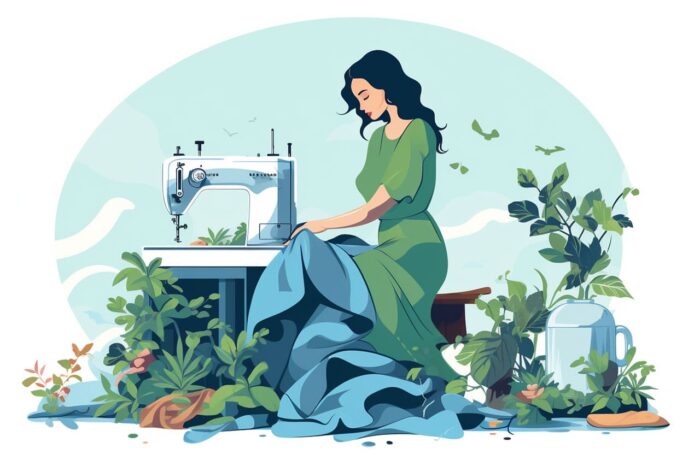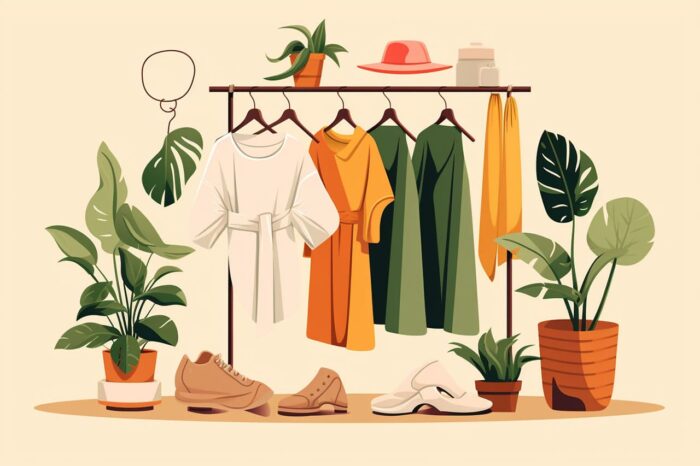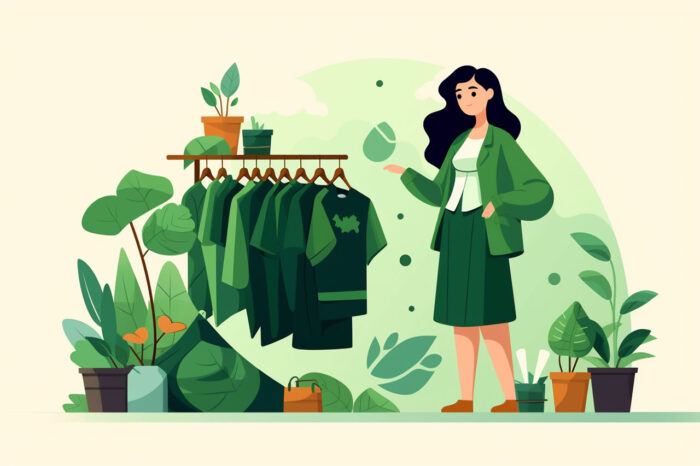In the ever-evolving world of fashion, an ethereal presence has quietly emerged, disrupting the norm. An entity that whispers of responsibility, of preservation, of a future where style doesn’t bleed the earth dry. A notion known as sustainable fashion. It’s a concept that binds threads of eco-friendly practices, ethical labor, and innovative designs into a beautiful tapestry of sustainable affordable fashion. A plethora of sustainable fashion brands have taken root, each with a unique narrative, etching their mark on the fashion landscape.
However, an important question hangs in the air, what is sustainable fashion? It’s more than just a trend, it’s a revolution that veers away from the fast fashion model. It embraces a slower, conscious approach. A approach where garments are not just tossed away but treasured. Where sustainable fashion companies take the helm, steering the industry away from harmful practices and towards a future where fashion is not just about vanity, but about values. It’s a future where looking good doesn’t compromise feeling good about the choices we make.
What is Sustainable Fashion?

Let’s delve into the realm of Sustainable Fashion. Initially, we’ll explore its definition and significance. Next, we’ll consider the benefits this practice brings to our environment and society. In contrast, we’ll scrutinize the damaging impact of Fast Fashion. Moving forward, we’ll showcase prominent Sustainable Fashion Brands leading the way. Lastly, we’ll highlight the vital role of consumers in driving Sustainable Fashion.
Definition of Sustainable Fashion
Bursting forth from the cocoon of our previous conversation, let’s now flutter gently towards a new realm, Sustainable Fashion. But what, you may ask, is this seemingly contradictory term? In essence, sustainable fashion is a movement and process fostering change to fashion products and the fashion system towards greater ecological integrity and social justice. It’s an umbrella term that encapsulates ethical fashion, slow fashion, and eco fashion.
Sustainable fashion isn’t merely about employing organic cotton and other eco-friendly materials. It’s about creating an ecosystem where every cog, from the raw material suppliers to the end consumers, is conscious and respectful of the environment and human rights. It’s a journey that involves understanding the life cycle of garments, from design, raw material production, manufacturing, transport, storage, marketing, and final sale, to use, reuse, repair, remake and recycling of the product and its components. This is what makes it a truly unique fashion movement.
Benefits of Sustainable Fashion
Gently floating in the breeze, imagine a world where fashion not only dazzles our senses but also nurtures our Mother Earth. Sustainable fashion is the golden thread weaving this dream into reality. So, what are the benefits of sustainable fashion?
At its heart, sustainable fashion whispers a love story between fashion and the environment. It significantly reduces harmful environmental impacts by utilizing eco-friendly materials and methods. The carbon footprint of your wardrobe shrinks dramatically, and water usage is drastically cut down.
Not only does sustainable fashion embrace the environment, but it also cuddles up to human rights. By promoting fair trade, it ensures that every hand that touches your clothes is treated with dignity and respect, receiving a fair wage and working in safe conditions.
Moreover, sustainable fashion goes beyond the fleeting trends, offering timeless quality. It is about investing in pieces that last longer, reducing the overall consumption and waste.
The Impact of Fast Fashion
Sashaying from the topic of sustainable fashion, let’s now pirouette into the impact of its nemesis: fast fashion. A term that sounds as fleeting as its manufacturing process, fast fashion refers to the rapid production of high-fashion designs at low costs, typically with low-quality, environmentally damaging materials. This unsustainable practice has a dark side, creating a staggering environmental footprint that affects our air, water and soil.
Fast fashion is often synonymous with throwaway culture, where clothes are discarded as easily as they are bought. This leads to an increase in textile waste, contributing significantly to the global waste crisis. Moreover, the fast fashion industry is notorious for its exploitation of workers, often providing appalling working conditions and pitiful wages.
The impact of fast fashion is a grim reminder of the urgency to shift towards sustainable fashion. It is our responsibility to ensure the clothes we wear do not carry a hidden cost to the environment or humanity.
Sustainable Materials

Exploring sustainable materials uncovers an array of possibilities. Natural fibers like cotton and wool are traditional, yet crucial. Moving forward, recycled materials, such as plastic bottles, have reshaped the industry. Meanwhile, sustainable synthetics offer innovative, eco-friendly substitutes. Not to be overlooked, bamboo and hemp textiles serve as robust, rapid-growing resources. Peering toward the horizon, the future of sustainable fashion materials brims with potential, poised to revolutionize our wardrobes while protecting our planet.
Natural Fibers
Breaking away from the fast-fashion norms, we now turn our gaze towards materials that are at the heart of sustainable fashion. Let’s dive deep into Natural Fibers, a domain that’s as old as civilization itself, yet continues to amaze us with its eco-friendly credentials.
Natural fibers are a treasure trove of sustainability, spun from the very essence of Mother Earth. They are derived from plant, animal, or mineral sources, including cotton, linen, wool, and silk, and they biodegrade naturally over time. Cultivating these fibers often requires lesser energy and water compared to synthetic counterparts, thus leaving a smaller carbon footprint.
However, the beauty of natural fibers extends beyond their green roots. They offer an unmatchable comfort and breathability, making them a favorite choice for conscious fashion enthusiasts. As we step into a future where sustainability is not just a trend but a necessity, natural fibers are paving the way for a fashion revolution.
Recycled Materials
Following the thread of sustainable fashion, we now weave into the narrative of recycled materials. As the name suggests, recycled materials are those that have lived past lives. They’re the reincarnated heroes of the fashion world, bringing a new lease of life to discarded items.
One cannot underscore enough the role of recycled polyester. Made from discarded plastic bottles, it’s a wonderful antidote to the plastic waste problem plaguing our planet. Then there are regenerated fibers like Econyl, a synthetic material repurposed from industrial plastic, waste fabric, and fishing nets from the oceans.
But the crown jewel of recycled materials is perhaps recycled cotton. This eco-friendly alternative reduces the colossal water footprint associated with regular cotton production.
By using recycled materials, we’re not only reducing waste but also conserving resources. In the grand tapestry of sustainable fashion, these materials are the vibrant, eco-conscious threads that shape a more sustainable and stylish future.
Sustainable Synthetics
Swirling from the narrative of sustainable fashion, let’s now delve into the colorful sphere of Sustainable Synthetics. After all, not all plastics are villains in our eco-narrative. Today, we have a new breed of synthetics that are far kinder to our lovely planet. They are the sustainable synthetics.
These are materials born out of petrochemicals, but with a green twist. They are designed to be reused, recycled or decomposed, leaving a much smaller carbon footprint. A shining example is recycled polyester made from discarded plastic bottles. Another is Econyl, a type of nylon made from waste products like fishing nets and fabric scraps. Sustainable synthetics can also be biodegradable, like PLA, a polymer derived from renewable resources like corn starch.
In essence, sustainable synthetics represent a promising frontier in the realm of eco-friendly fashion materials. They offer the allure of traditional synthetics without the guilt of environmental degradation.
Sustainable Manufacturing

In the realm of Sustainable Manufacturing, a spectrum of unique practices exist. Starting with Fair Trade Practices, which underscore equitable business transactions, we move to Ethical Labor Standards that uphold workers’ rights. Then, we delve into Green Manufacturing Processes, emphasizing environment-friendly production techniques. In tandem, we explore Sustainable Packaging, promoting reduced waste and resource conservation. Lastly, the innovative concept of Upcycling in Production turns waste into value, completing our journey through sustainable manufacturing.
Fair Trade Practices
As we pivot from sustainable materials, let’s dive into a world where commerce is kinder, fairer, and greener – welcome to the realm of sustainable manufacturing. Specifically, let’s explore the cornerstone of this realm: Fair Trade Practices.
The fair trade journey begins with a unique transaction, not merely an exchange of goods and services, but an ethical pact. This pact guarantees fair prices for producers in developing countries, thus enhancing their living conditions and promoting sustainable farming practices. It’s not just about the trade, but the humanity behind the trade.
Fair trade practices take the conventional business model and turn it on its head. It’s about more than just profit; it’s about creating a balance between economic success and social responsibility. It’s about making sure that every hand that touches a product, from seed to shelf, is treated with the respect and dignity they deserve. It is, in essence, a trade of fairness.
Ethical Labor Standards
Transitioning from the topic of sustainable materials, let’s delve into a dimension that often gets neglected – Ethical Labor Standards. Just as we are conscious of the materials we use, we should also be aware of the hands that mold them. After all, sustainability is not just about environmental responsibility, but also about human dignity.
Ethical labor standards are a cornerstone of sustainable manufacturing. This involves providing safe working conditions, fair wages, reasonable working hours, and respect for workers’ rights. Sadly, these are not always a given in many industries. As consumers, we can support companies that prioritize ethical labor practices, making a stand against child labor, forced labor, and other exploitative practices.
Remember, a truly sustainable product is one that is not only created with eco-friendly materials and processes, but also one that respects and values the people behind its creation. Together, let’s advocate for sustainability with a human touch.
Green Manufacturing Processes
Softly embracing the concept of eco-conscious materials, let’s dive into the vibrant, dynamic world of Green Manufacturing Processes. These processes are not just a mere trend but a profound revolution in the way we create our goods.
In this lush, green world of manufacturing, waste is seen not as trash, but as a resource waiting to be harnessed. Consider it akin to alchemy, transforming the mundane into the extraordinary. Think of factories powered by renewable energy, producing zero wastes, and emitting no harmful substances. These are not utopian dreams, but tangible actions being taken by pioneers in the industry.
The green manufacturing process is an invitation to rethink and reengineer our production methods. It’s about finding innovative ways to reduce, reuse, and recycle during production, minimizing environmental impacts. This approach is not just about doing the right thing, it’s also about improving efficiency and saving money. Indeed, green manufacturing is the golden thread connecting sustainability, innovation, and profitability.
Shopping for Sustainable Fashion

When shopping for sustainable fashion, researching brands is crucial for understanding their eco-friendly practices. We then look into seeking certifications – these validate the sustainability claims of the brands. We also focus on evaluating product quality because longevity is a key aspect of sustainability. In addition, identifying ethical brands is paramount; we support companies that value their workers and environment. Lastly, we delve into balancing style and sustainability, because being fashionable doesn’t mean compromising our planet’s health. Shopping sustainably is an art that requires responsibility, discernment, and a keen eye for style.
Researching Brands
Just as a diamond is meticulously cut and polished, a conscientious consumer too must refine their approach. Transitioning from the larger panorama of sustainable manufacturing, let’s delve into the intricate details of shopping for sustainable fashion. To make your fashion choices truly sustainable, the first step is to research brands thoroughly.
While every brand today seems to have attached the ‘sustainable’ tag to itself, not all are genuine. Researching brands involves going beyond the surface and checking their sustainability claims. Look for information about the brand’s sourcing policies, manufacturing processes, and waste management. Are their fabrics organic and eco-friendly? Do they use renewable energy sources in production? How do they handle waste?
In the age of the internet, the answers to these questions are just a click away. Remember, your transition to a sustainable wardrobe starts with knowledge. As the saying goes, knowledge is power. In this case, it’s the power to make a difference.
Seeking Certifications
In the same breath that we marvel at the ingenuity of sustainable manufacturing, let’s dive into the world of fashion, where sustainability becomes not just a concept, but a tangible reality. Let’s touch upon the fascinating realm of seeking certifications.
Certifications are your secret weapons in the quest to shop sustainably. They’re like a complex code that, once deciphered, become your guide to navigate the labyrinth of sustainable fashion. Keep an eye out for the Global Organic Textile Standard (GOTS), Fairtrade, and the Better Cotton Initiative (BCI) among others. These certifications guarantee that a brand is meeting certain sustainability criteria, validating their commitment to the environment.
However, beware of greenwashing. This is where brands create an illusion of sustainability, without actually contributing to it. Certifications should not be the only factor to trust a brand’s sustainability claims. They are merely a piece of the bigger picture, a jigsaw puzzle of sustainable fashion.
Evaluating Product Quality
Drifting from the realms of sustainable manufacturing, we now embark on a journey of conscious consumerism, specifically within the sphere of fashion. A key compass guiding us in the right direction is Evaluating Product Quality.
Excellence in craftsmanship is a hallmark of sustainable fashion. High-quality products last longer, reducing the need for frequent replacements and consequently decreasing waste. Therefore, inspecting the quality of materials and craftsmanship is crucial. Check for robust stitching, durable fabrics, and precise finishes. Avoid synthetic materials like polyester, which are not biodegradable and contribute to microfiber pollution.
Additionally, be aware that a product’s quality extends beyond its physical attributes. It also encompasses the conditions under which it was made. Brands that prioritize fair wages, safe working conditions, and responsible sourcing practices are, by default, producing a higher quality, more sustainable product. Thus, the quality evaluation is a multi-layered process that goes hand in hand with ethical and sustainable choices.
Sustainable Care and Maintenance

Hand washing and line drying not only elongate the life of clothes but also reduce energy consumption. Following this, we’ll look at repairing and restyling as additional sustainable care practices, offering a creative way to preserve old garments. Then, we’ll delve into clothes repair and upcycling, discussing the double benefit of minimizing waste and creating unique fashion pieces. Lastly, we’ll discuss the importance of reducing fashion waste in the fight against environmental degradation. In summary, each of these steps is a stride toward more sustainable care and maintenance of our clothes.
Hand Washing
Having embraced the charm of sustainable fashion, how can we ensure our cherished pieces last and continue to tell their enchanting tale? Let’s delve into the art of hand washing.
Hand washing, a seemingly simple task, is actually a unique ritual that transforms the mundane into the extraordinary. It is the gentlest way to clean your clothes, preserving their structure and maintaining their vibrant hues. Imagine the cool water flowing over your hands, the rhythmic swishing of fabric, the soothing scent of eco-friendly detergents. This process is not only a means of extending the life of your garments but also an act of mindfulness, connecting you to the clothes you wear.
Yet, hand washing is more than just a cleaning procedure, it’s a step towards sustainability. By washing less frequently, using less water, and foregoing harsh chemicals, we keep our clothes lasting longer, thus contributing to a more sustainable fashion cycle.
Line Drying
As we step away from the bustling lanes of sustainable fashion shopping, let’s wander into the tranquil oasis of sustainable care and maintenance. The whispers of the wind gently brushing against your freshly washed clothes on the line is a lullaby for the environment. Line drying, this underrated hero, consumes zero energy and imparts a sun-kissed freshness to your clothes.
Imagine the contrast: a power-hungry tumble dryer churning away, versus your favorite dress dancing freely in the breeze. Not only does line drying help in preserving the life of your garments, but it also eliminates the synthetic fibres that go into water systems from conventional drying methods.
And let’s not forget, the sight of clothes fluttering in the wind is akin to an everyday poetry in motion. So, let’s pledge to bring back the timeless tradition of line drying, and embrace the joy of sustainable care for our treasured purchases.
Repairing and Restyling
From shopping consciously to maintaining your wardrobe, sustainability is a journey. Now that you’ve refreshed your closet with mindfully-made threads, it’s time to explore how you can extend their lifespan. Enter the realm of repairing and restyling.
In the fast-fashion world, we’re often tempted to toss an item as soon as a button falls off or a seam comes loose, but that’s not the sustainable way. Instead, embrace DIY repairs. Learn how to sew on a missing button, fix a broken zipper, or mend a tear. Not only will this give your clothes a longer lifespan, it’s also an opportunity to add a personal touch to your garments.
Moreover, don’t be afraid to restyle your clothes. A long dress can become a chic skirt, or an oversized shirt can be transformed into a trendy crop top. This creative process breathes new life into old clothes and reduces the need for new purchases. Remember, sustainability isn’t just about buying — it’s about making it last.
Sustainable Shopping Alternatives

Venturing into sustainable shopping alternatives, thrifting offers a trove of unique, pre-loved items. If you need something temporarily, consider renting instead of buying new. For those who prefer ownership, buying used is another eco-friendly option. In the realm of adornments, ethical jewelry brands provide beautiful pieces without exploiting resources or labor. Finally, sustainable footwear ensures your fashion footprint is light on the planet. Explore these options for a more responsible shopping journey.
Thrifting
Having sketched the broad strokes of sustainable care and maintenance, let’s now peruse the intriguing world of sustainable shopping alternatives. A fascinating starting point in this journey is the age-old, evergreen practice of thrifting.
Thrifting, or buying second-hand items, is a sustainable shopping alternative that can be both economical and enjoyable. It allows you to give a second life to items that might have otherwise ended up in a landfill, thereby reducing the need to produce new ones. In this way, thrifting contributes to cutting down on environmental waste and reducing the carbon footprint. It’s not just about clothes; you can thrift anything from books to furniture, electronics to vintage jewelry.
And let’s not forget the thrill of the hunt. You never know what gems you might discover in a thrift store – a classic designer piece, a rare book, or even an antique. Ultimately, thrifting is a stylish, green, and budget-friendly way of shopping that adds a unique charm to your collection.
Renting
Emerging from the realm of sustainable care and maintenance, we step into a world of sustainable acquisition. A world where responsibility and style blend seamlessly together, offering an alternative approach that champions both the environment and your wallet.
Renting, our focus in this section, offers a unique solution to fast fashion and excessive consumption. Rather than purchasing a new outfit for every occasion, consider the concept of renting. High-end fashion rental services such as Rent the Runway or Le Tote allow you to wear trendy and luxurious outfits without the commitment and expense of owning them. This practice not only reduces clothing waste but also allows for more diverse and dynamic wardrobe options.
Make a fashion statement that speaks volumes about your commitment to sustainability. Renting, no longer just for cars and houses, is now a bold and unique approach to sustainable fashion.
Buying Used
Stepping from the realm of personal care and maintenance, we cross the threshold into the bustling marketplace of sustainable consumerism. In this vibrant bazaar, the stalls are laden not with new, gleaming items but rather, with pre-loved treasures waiting for a new home.
Buying used is more than just a bargain hunter’s hobby; it’s a powerful statement in the face of our throwaway culture. It respects the resources and labor that have already been invested into creating an item. It’s a way of saying, “Enough with the waste, the excess, the disposable mindset!“
Many online platforms, such as eBay, Depop, and Poshmark, have made it easier than ever to find used items in excellent condition. From vintage clothing to second-hand furniture, these items come with their own stories, adding a unique charm to your personal style or home decor.
So, next time you’re on the hunt for something, consider the used market.
Sustainable Shopping Tips

Embrace the art of minimalism through buying less. Next, let’s explore how shopping locally can reduce your carbon footprint, while supporting small businesses boosts local economies and encourages entrepreneurship. Pivot to a long-term mindset by investing in timeless pieces, reducing waste and enhancing your personal style. Lastly, dive into fair trade fashion, a powerful practice promoting fair wages and ethical working conditions. These are your keys to sustainable shopping.
Buying Less
Navigating from the waves of sustainable shopping alternatives, let us now anchor ourselves on the shores of practical tips to incorporate sustainability into our shopping habits. The first pearl of wisdom in this treasure chest is the concept of Buying Less.
The idea of buying less may seem rather counterintuitive in our consumer-driven culture. Yet, this concept is inherently unique, defying the norm of purchasing more and more. Buy less, but better. Aim to reduce your consumption by making mindful choices. Every time you decide not to buy an unnecessary item, you’re not just saving money; you’re also contributing to a reduction in the demand for excessive production.
This minimalist approach is not a call to renounce all worldly possessions, but rather an invitation to take a step back, reflect, and invest in quality over quantity. The choice is yours. Choose less, choose better, choose sustainability.
Shopping Locally
Delving deeper into our discussion on sustainable shopping, let’s illuminate the manifold benefits of Shopping Locally. Not only does it aid in cutting back on transportation emissions, but it also fosters a more intimate relationship with your purchases.
When you shop from local businesses, you’re not just buying a product, you’re supporting a story, a family, and a dream. These items hold more than just material value; they carry the essence of your community and its unique craftsmanship. Moreover, you can easily inquire about the source of materials and manufacturing processes, ensuring your purchases align with sustainable practices.
Remember, Shopping Locally is not just about the geographical location. It’s also about investing in the local economy, supporting artisans, and reducing your carbon footprint. It’s about making a conscious decision to prioritize quality over quantity and sustainability over convenience. In essence, it’s about fostering a more responsible and sustainable lifestyle, one purchase at a time.
Supporting Small Businesses
Moving on from the eco-friendly alternatives available in the market, let’s shift our gaze towards another aspect of sustainable shopping: supporting small businesses. Small businesses are often overlooked in the hustle and bustle of the capitalist world. However, they play a significant role in promoting sustainability.
When you shop from small businesses, you are supporting a dream. Furthermore, these businesses often have more sustainable practices as they source their materials locally and have a lesser carbon footprint. Small is powerful in the world of sustainability. Many small businesses also prioritize quality over quantity, which aligns perfectly with the sustainability mantra of ‘buy less, but better.’
Not to mention, shopping small also means supporting your local community and economy. So, the next time you’re about to click ‘add to cart’ on a multinational website, take a moment to consider the little guys making a big difference. Try to find a small business that aligns with your values and supports them.
Supporting Sustainable Fashion

In supporting sustainable fashion, it is vital to share your knowledge on eco-friendly practices. Equally important is supporting sustainability initiatives, which can range from recycling to energy conservation. A simple yet impactful method is donating to charities that promote sustainable fashion. Additionally, choosing brands that adhere to ethical manufacturing processes is a powerful statement. Finally, the slow fashion movement, which emphasizes quality over quantity, plays a crucial role in sustainable fashion.
Sharing Your Knowledge
Just as we’ve explored how to shop sustainably, let’s now dive into the world of sustainable fashion. It’s a realm where style meets ethics, and where every garment tells a tale of responsible consumption.
The journey to sustainable fashion begins with Sharing Your Knowledge. Knowledge is power and when it comes to sustainable fashion, it’s the power to make a difference. Start small, like discussing the benefits of organic cotton with a friend, or sharing an article about the harmful effects of fast fashion on social media. Take the initiative to host fashion swap parties, letting your friends know that stylish doesn’t have to mean new. Engage your community in a discussion on the importance of supporting businesses that prioritize fair trade and ethical manufacturing. Remember, every conversation you foster about sustainable fashion is a step toward a more mindful and eco-friendly fashion industry.
Supporting Sustainability Initiatives
Moving from mindful buying practices, let’s now dive into how you can support sustainability initiatives. Let your money do the talking. Consider backing brands and companies that are actively engaged in sustainable practices. These initiatives can range from the use of recycled materials, to carbon offsetting, and even tree planting. Actively seek out these brands and show your support by purchasing their products or services. Additionally, you can take an extra step by promoting these companies on your social media platforms, spreading the word about their sustainability efforts. Remember, supporting sustainability initiatives doesn’t just mean throwing money at the problem. It’s about making conscious choices, promoting these choices, and encouraging others to follow suit. This is a unique way of ensuring that our planet remains healthy for future generations. Supporting sustainability is more than a trend, it’s a lifestyle.
Donating to Charities
Having equipped ourselves with eco-friendly shopping practices, let’s dive into the ocean of promoting sustainable fashion. A powerful way to contribute to this cause is by donating to charities that are making waves in the fashion industry.
Charitable organizations, like the Fashion Revolution Foundation or Clean Clothes Campaign, are committed to advocating for ethical and sustainable practices in the fashion industry. By donating to these charities, you’re contributing to a cause that fights for transparency, equity, and sustainability in fashion.
You see, these charities use your donations to push for legislative changes, conduct research, and provide support to workers in underprivileged conditions. So, your monetary contributions aren’t just funds— they’re catalysts for change, empowering the underprivileged and protecting the environment. By donating to such charities, you’re not just wearing your values on your sleeve, you’re also stitching them into the very fabric of the fashion industry.
Conclusion
In conclusion, sustainable fashion isn’t just a trend, but a lifestyle choice. By consciously choosing sustainable fashion brands and supporting sustainable fashion companies, we contribute to a healthier planet.
Incorporating what is sustainable fashion into your lifestyle may seem daunting at first, but with the rise of sustainable affordable fashion, it’s easier than ever. Ultimately, our choices can make a significant impact on the wider fashion industry, promoting sustainability at every step.